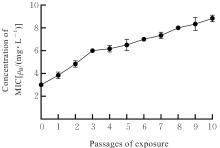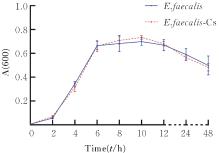| 1 |
SIQUEIRA J F Jr, ANTUNES H S, PÉREZ A R, et al. The apical root canal system of teeth with posttreatment apical periodontitis: correlating microbiologic, tomographic, and histopathologic findings[J]. J Endod, 2020, 46(9): 1195-1203.
|
| 2 |
SONG J Z, HONG L H, ZOU X Y, et al. A self-supplying H2O2 modified nanozyme-loaded hydrogel for root canal biofilm eradication[J]. Int J Mol Sci, 2022, 23(17): 10107.
|
| 3 |
BROOKES Z L S, BESCOS R, BELFIELD L A, et al. Current uses of chlorhexidine for management of oral disease: a narrative review[J]. J Dent, 2020, 103: 103497.
|
| 4 |
HUANG S, WU M J, LI Y J, et al. The dlt operon contributes to the resistance to chlorhexidine in Streptococcus mutans [J]. Int J Antimicrob Agents, 2022, 59(3): 106540.
|
| 5 |
EMILSON C G, ERICSON T, LILJA J, et al. Effect of chlorhexidine on human oral streptococci[J]. J Periodontal Res, 1972, 7(2): 189-191.
|
| 6 |
张 鹏, 车丽赫, 郭志敏, 等. 泌尿系统感染患者病原菌的分布及其耐药性分析[J]. 吉林大学学报(医学版), 2015, 41(3): 593-598.
|
| 7 |
CODELIA-ANJUM A, LERNER L B, ELTERMAN D, et al. Enterococcal urinary tract infections: a review of the pathogenicity, epidemiology, and treatment[J]. Antibiotics, 2023, 12(4): 778.
|
| 8 |
PEDRINHA V F, CUELLAR M R C, DE BARROS M C, et al. The vehicles of calcium hydroxide pastes interfere with antimicrobial effect, biofilm polysaccharidic matrix, and pastes' physicochemical properties[J]. Biomedicines, 2022, 10(12): 3123.
|
| 9 |
BARBOSA-RIBEIRO M, DE-JESUS-SOARES A, ZAIA A A, et al. Antimicrobial susceptibility and characterization of virulence genes of Enterococcus faecalis isolates from teeth with failure of the endodontic treatment[J]. J Endod, 2016, 42(7): 1022-1028.
|
| 10 |
胡 涛, 雷 蕾, 周学东. 顽固感染根管内粪肠球菌的致病机制及其控制方法进展[J]. 中华口腔医学杂志, 2022, 57(1): 10-15.
|
| 11 |
PERSONNIC N, DOUBLET P, JARRAUD S. Intracellular persister: a stealth agent recalcitrant to antibiotics[J]. Front Cell Infect Microbiol, 2023, 13: 1141868.
|
| 12 |
GAETA C, MARRUGANTI C, ALI I A A, et al. The presence of Enterococcus faecalis in saliva as a risk factor for endodontic infection[J]. Front Cell Infect Microbiol, 2023, 13: 1061645.
|
| 13 |
BASSLER B L, LOSICK R. Bacterially speaking[J]. Cell, 2006, 125(2): 237-246.
|
| 14 |
WANG Y, LIU B B, GRENIER D, et al. Regulatory mechanisms of the LuxS/AI-2 system and bacterial resistance[J]. Antimicrob Agents Chemother, 2019, 63(10): e01186-e01119.
|
| 15 |
SMITH W P J, WUCHER B R, NADELL C D, et al. Bacterial defences: mechanisms, evolution and antimicrobial resistance[J]. Nat Rev Microbiol, 2023, 21(8): 519-534.
|
| 16 |
CHAO Y Q, GUO F, FANG H H, et al. Hydrophobicity of diverse bacterial populations in activated sludge and biofilm revealed by microbial adhesion to hydrocarbons assay and high-throughput sequencing[J]. Colloids Surf B Biointerfaces, 2014, 114: 379-385.
|
| 17 |
陈 珺, 罗智伟, 曾心怡, 等. 上颌侧切牙重度畸形舌侧沟多学科联合治疗1例并文献复习[J]. 中南大学学报(医学版), 2023, 48(2): 302-310.
|
| 18 |
THEOPHEL K, SCHACHT V J, SCHLÜTER M, et al. The importance of growth kinetic analysis in determining bacterial susceptibility against antibiotics and silver nanoparticles[J]. Front Microbiol, 2014, 5: 544.
|
| 19 |
MAVRI A, SMOLE MOŽINA S. Development of antimicrobial resistance in Campylobacter jejuni and Campylobacter coli adapted to biocides[J]. Int J Food Microbiol, 2013, 160(3): 304-312.
|
| 20 |
DOLL-NIKUTTA K, WINKEL A, YANG I, et al. Adhesion forces of oral bacteria to titanium and the correlation with biophysical cellular characteristics[J]. Bioengineering, 2022, 9(10): 567.
|
| 21 |
BOUTSIOUKIS C, ARIAS-MOLIZ M T. Present status and future directions - irrigants and irrigation methods[J]. Int Endod J, 2022, 55(): 588-612.
|
| 22 |
PARGA A, MANOIL D, BRUNDIN M, et al. Gram-negative quorum sensing signalling enhances biofilm formation and virulence traits in gram-positive pathogen Enterococcus faecalis [J]. J Oral Microbiol, 2023, 15(1): 2208901.
|
| 23 |
WANG Q Q, WEI S D, SILVA A F, et al. Cooperative antibiotic resistance facilitates horizontal gene transfer[J]. ISME J, 2023, 17(6): 846-854.
|
| 24 |
AQAWI M, SIONOV R V, FRIEDMAN M, et al. The antibacterial effect of cannabigerol toward Streptococcus mutans is influenced by the autoinducers 21-CSP and AI-2[J]. Biomedicines, 2023, 11(3): 668.
|
| 25 |
RAMIĆ D, JUG B, ŠIMUNOVIĆ K, et al. The role of luxS in campylobacter jejuni beyond intercellular signaling[J]. Microbiol Spectr, 2023, 11(2): e0257222.
|
| 26 |
CH’NG J H, CHONG K K L, LAM L N, et al. Biofilm-associated infection by Enterococci [J]. Nat Rev Microbiol, 2019, 17(2): 82-94.
|
| 27 |
YANG Y, LI W Z, HOU B X, et al. Quorum sensing LuxS/autoinducer-2 inhibits Enterococcus faecalis biofilm formation ability[J]. J Appl Oral Sci, 2018, 26: e20170566.
|
 )
)
 )
)






